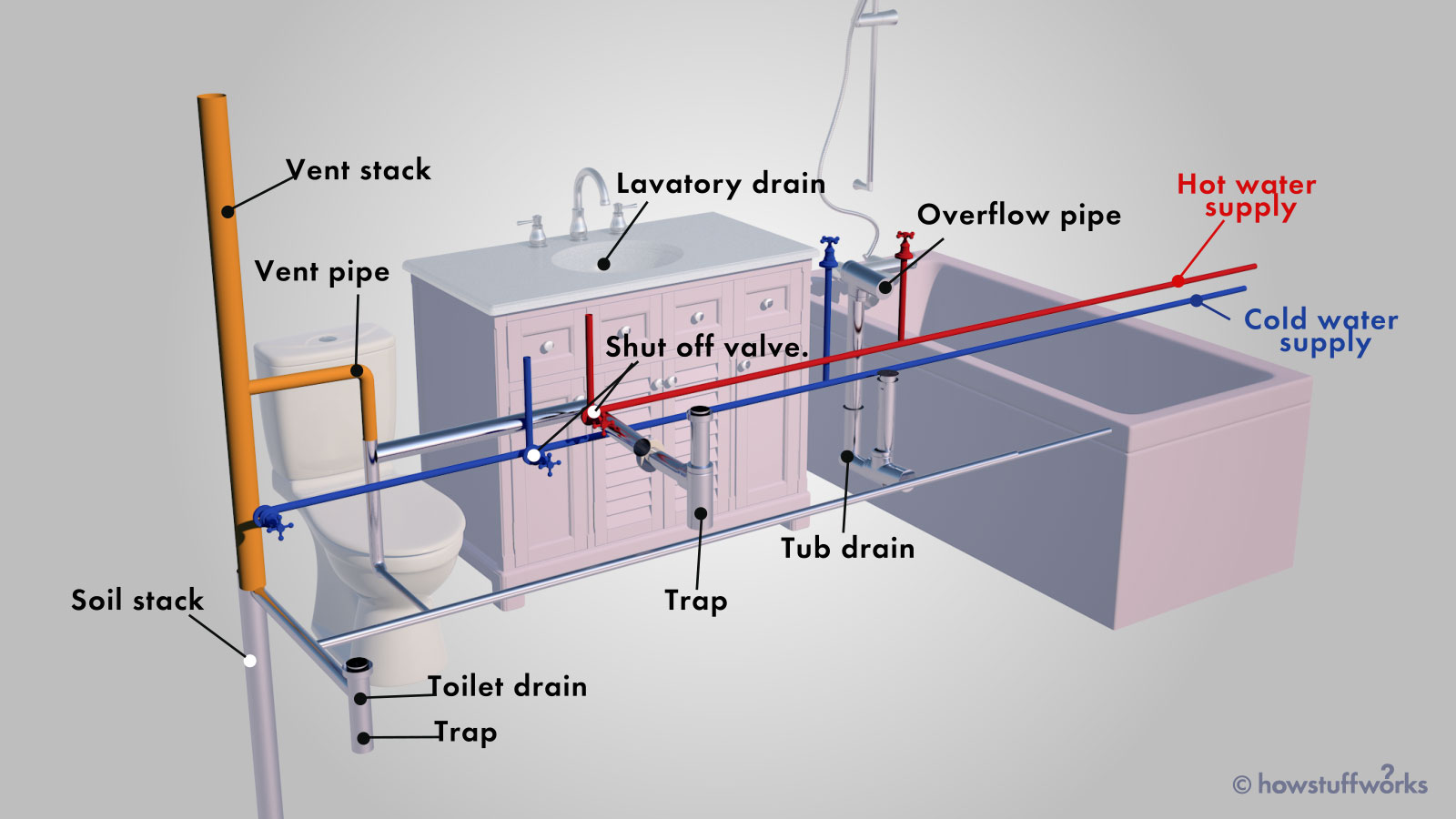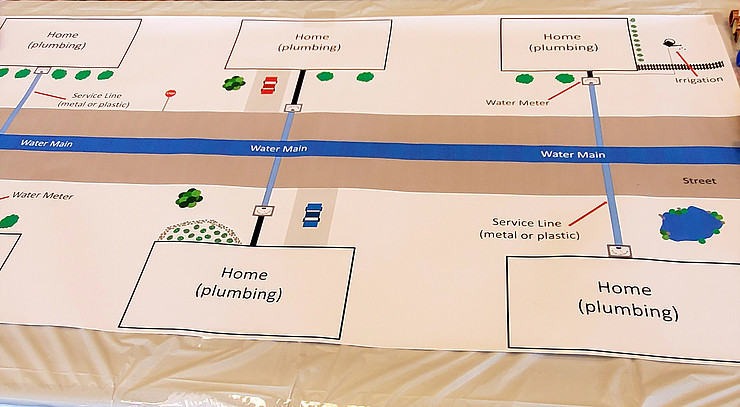The Complete Look at Your Property's Plumbing System Anatomy
The Complete Look at Your Property's Plumbing System Anatomy
Blog Article
How do you actually feel in relation to Anatomy of a House: Understanding the Components?

Understanding exactly how your home's plumbing system works is vital for each house owner. From providing tidy water for alcohol consumption, cooking, and bathing to safely getting rid of wastewater, a properly maintained pipes system is vital for your household's health and convenience. In this detailed overview, we'll check out the elaborate network that comprises your home's plumbing and deal suggestions on maintenance, upgrades, and taking care of usual issues.
Intro
Your home's pipes system is greater than just a network of pipelines; it's a complex system that guarantees you have access to clean water and efficient wastewater elimination. Understanding its elements and how they collaborate can aid you avoid pricey repair work and make sure every little thing runs smoothly.
Fundamental Components of a Pipes System
Pipes and Tubes
At the heart of your plumbing system are the pipelines and tubing that bring water throughout your home. These can be made of different materials such as copper, PVC, or PEX, each with its advantages in terms of toughness and cost-effectiveness.
Fixtures: Sinks, Toilets, Showers, etc.
Components like sinks, bathrooms, showers, and bath tubs are where water is utilized in your home. Understanding just how these fixtures link to the pipes system assists in diagnosing troubles and intending upgrades.
Valves and Shut-off Factors
Valves manage the flow of water in your plumbing system. Shut-off valves are important throughout emergencies or when you require to make fixings, enabling you to separate parts of the system without disrupting water circulation to the whole house.
Water System
Key Water Line
The major water line connects your home to the municipal water supply or a personal well. It's where water enters your home and is dispersed to various components.
Water Meter and Pressure Regulator
The water meter steps your water usage, while a stress regulator makes certain that water flows at a risk-free stress throughout your home's pipes system, preventing damages to pipelines and fixtures.
Cold Water vs. Hot Water Lines
Comprehending the distinction in between cold water lines, which supply water straight from the major, and warm water lines, which carry heated water from the water heater, assists in repairing and planning for upgrades.
Water drainage System
Drain Pipes and Traps
Drain pipelines carry wastewater away from sinks, showers, and bathrooms to the drain or sewage-disposal tank. Traps avoid drain gases from entering your home and also trap debris that might trigger blockages.
Ventilation Pipelines
Air flow pipelines allow air into the drainage system, avoiding suction that could slow down drain and trigger traps to empty. Appropriate ventilation is necessary for keeping the honesty of your plumbing system.
Importance of Proper Drainage
Ensuring correct water drainage protects against back-ups and water damages. Consistently cleaning up drains pipes and preserving traps can avoid costly repairs and prolong the life of your plumbing system.
Water Heating System
Sorts Of Hot Water Heater
Hot water heater can be tankless or standard tank-style. Tankless heating units warm water on demand, while tanks save warmed water for instant use.
How Water Heaters Connect to the Pipes System
Recognizing just how water heaters connect to both the cold water supply and warm water circulation lines assists in diagnosing concerns like inadequate hot water or leaks.
Upkeep Tips for Water Heaters
On a regular basis flushing your water heater to get rid of debris, inspecting the temperature settings, and checking for leaks can extend its life-span and enhance energy efficiency.
Usual Plumbing Issues
Leakages and Their Causes
Leaks can take place due to maturing pipes, loosened installations, or high water stress. Dealing with leaks promptly protects against water damages and mold and mildew growth.
Clogs and Blockages
Obstructions in drains pipes and bathrooms are usually brought on by flushing non-flushable items or a build-up of oil and hair. Using drainpipe displays and bearing in mind what drops your drains can prevent blockages.
Signs of Pipes Problems to Expect
Low water pressure, slow-moving drains, foul odors, or unusually high water bills are indicators of potential pipes problems that must be addressed immediately.
Plumbing Upkeep Tips
Regular Assessments and Checks
Set up annual pipes inspections to catch problems early. Seek signs of leaks, deterioration, or mineral buildup in taps and showerheads.
DIY Maintenance Tasks
Straightforward tasks like cleansing tap aerators, checking for commode leakages using dye tablet computers, or insulating subjected pipelines in cool climates can avoid significant plumbing problems.
When to Call an Expert Plumber
Know when a pipes issue needs professional experience. Trying complex repair services without correct expertise can result in even more damage and greater repair expenses.
Upgrading Your Plumbing System
Factors for Upgrading
Updating to water-efficient fixtures or changing old pipelines can boost water quality, lower water bills, and increase the worth of your home.
Modern Pipes Technologies and Their Benefits
Check out technologies like wise leakage detectors, water-saving toilets, and energy-efficient hot water heater that can conserve money and minimize ecological impact.
Cost Considerations and ROI
Compute the ahead of time prices versus long-term cost savings when thinking about pipes upgrades. Many upgrades pay for themselves with lowered utility expenses and less repairs.
Ecological Influence and Conservation
Water-Saving Components and Appliances
Setting up low-flow faucets, showerheads, and toilets can considerably decrease water use without giving up performance.
Tips for Lowering Water Usage
Easy practices like taking care of leakages without delay, taking shorter showers, and running complete lots of washing and dishes can conserve water and reduced your utility expenses.
Eco-Friendly Pipes Options
Take into consideration sustainable plumbing materials like bamboo for flooring, which is durable and environmentally friendly, or recycled glass for kitchen counters.
Emergency situation Readiness
Actions to Take During a Plumbing Emergency
Know where your shut-off valves lie and exactly how to shut off the supply of water in case of a burst pipeline or significant leakage.
Significance of Having Emergency Situation Calls Helpful
Keep contact information for neighborhood plumbing professionals or emergency services conveniently offered for fast feedback throughout a plumbing crisis.
Do It Yourself Emergency Situation Fixes (When Appropriate).
Short-term solutions like utilizing duct tape to spot a dripping pipe or placing a pail under a leaking faucet can decrease damage till a specialist plumbing technician gets here.
Final thought.
Understanding the makeup of your home's pipes system empowers you to keep it successfully, saving money and time on repair services. By following normal maintenance routines and remaining educated regarding modern pipes technologies, you can guarantee your plumbing system runs successfully for many years to come.
HOW YOUR PLUMBING SYSTEM WORKS
Which Pipes Do What?
Blue lines = fresh water supply entering the building
Red lines = hot water supply entering the building
Grey lines = pipes carrying waste away from the building and venting pipes carrying gases away from the building (through the roof)
YOUR MAIN PLUMBING SYSTEMS
There are two main plumbing systems that support your home s basic plumbing needs one that brings clean water into your home, and one that sends dirty water away from your home. Connected to the toilet, bath, shower, and other faucets in your home, these two systems keep your water flowing in the right directions.
ACCESSING FRESH WATER
Fresh and clean water is brought into your home through the main water supply line . Filtered through one pipe, this water is pressured to flow into the various fixtures in your home at any given time.
This water can be sourced from a well located on your property, a pond or river (mostly cottages), or, as in most cases, from the city s municipal water treatment centre. However, it is important to note that water that is untreated, such as the water siphoned from ponds or rivers, may not be safe to drink. Personal water supplies always need to be treated for hardness and contaminants before consumed.
MUNICIPAL WATER SUPPLIES
Improve taste and odour
Remove sediment
Eliminate hardness
Reduce chlorine
COLD WATER SUPPLY VS. HOT WATER SUPPLY
Cold water flows into your home or building through the service line, which then distributes hot or cold water to your fixtures. This line is most commonly run through a central column that runs floor to floor. Hot water runs in short and straight pipes as the longer the pipeline, the more heat that will be lost in the transfer. Having shorter pipes also allows residents to access hot water more quickly.
WASTE WATER SYSTEM
Your wastewater system is divided into two parts pipes that send wastewater away from your home and venting pipes that send sewer gas away from your home. Sewage water travels through pipes that flush the water and waste towards local sewers that are operated and managed by your city or town. Most sewer systems rely on gravity to move the wastewater to where it needs to go.
The further away from your toilet or sink, the larger wastewater pipes become. This allows for waste to be disposed of from various parts of your home or business at once without pipe blockages. The angle and flow of these pipes are also essential for keeping your waste pipes clear of build up.
https://harrisplumbing.ca/how-your-home-plumbing-system-works/

HOW YOUR PLUMBING SYSTEM WORKS
Which Pipes Do What?
YOUR MAIN PLUMBING SYSTEMS
There are two main plumbing systems that support your home s basic plumbing needs one that brings clean water into your home, and one that sends dirty water away from your home. Connected to the toilet, bath, shower, and other faucets in your home, these two systems keep your water flowing in the right directions.
ACCESSING FRESH WATER
Fresh and clean water is brought into your home through the main water supply line . Filtered through one pipe, this water is pressured to flow into the various fixtures in your home at any given time.
This water can be sourced from a well located on your property, a pond or river (mostly cottages), or, as in most cases, from the city s municipal water treatment centre. However, it is important to note that water that is untreated, such as the water siphoned from ponds or rivers, may not be safe to drink. Personal water supplies always need to be treated for hardness and contaminants before consumed.
MUNICIPAL WATER SUPPLIES
COLD WATER SUPPLY VS. HOT WATER SUPPLY
Cold water flows into your home or building through the service line, which then distributes hot or cold water to your fixtures. This line is most commonly run through a central column that runs floor to floor. Hot water runs in short and straight pipes as the longer the pipeline, the more heat that will be lost in the transfer. Having shorter pipes also allows residents to access hot water more quickly.
WASTE WATER SYSTEM
Your wastewater system is divided into two parts pipes that send wastewater away from your home and venting pipes that send sewer gas away from your home. Sewage water travels through pipes that flush the water and waste towards local sewers that are operated and managed by your city or town. Most sewer systems rely on gravity to move the wastewater to where it needs to go.
The further away from your toilet or sink, the larger wastewater pipes become. This allows for waste to be disposed of from various parts of your home or business at once without pipe blockages. The angle and flow of these pipes are also essential for keeping your waste pipes clear of build up.
https://harrisplumbing.ca/how-your-home-plumbing-system-works/
I came across that entry on Understanding Your Home's Plumbing Anatomy when exploring the search engines. Do you know about somebody who is fascinated with the niche? Why not share it. Thank you so much for going through it.
Book My Estimate Report this page